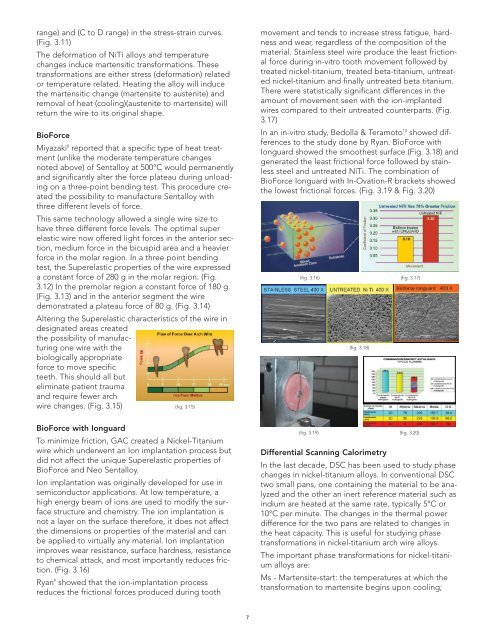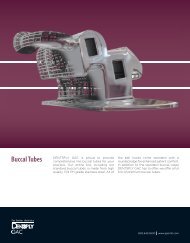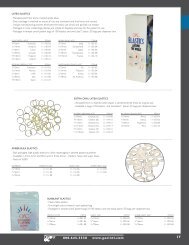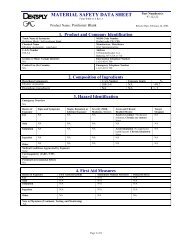SENTALLOY® - GAC International
SENTALLOY® - GAC International
SENTALLOY® - GAC International
You also want an ePaper? Increase the reach of your titles
YUMPU automatically turns print PDFs into web optimized ePapers that Google loves.
ange) and (C to D range) in the stress-strain curves.<br />
(Fig. 3.11)<br />
The deformation of NiTi alloys and temperature<br />
changes induce martensitic transformations. These<br />
transformations are either stress (deformation) related<br />
or temperature related. Heating the alloy will induce<br />
the martensitic change (martensite to austenite) and<br />
removal of heat (cooling)(austenite to martensite) will<br />
return the wire to its original shape.<br />
BioForce<br />
Miyazaki8 reported that a specific type of heat treatment<br />
(unlike the moderate temperature changes<br />
noted above) of Sentalloy at 500°C would permanently<br />
and significantly alter the force plateau during unloading<br />
on a three-point bending test. This procedure created<br />
the possibility to manufacture Sentalloy with<br />
three different levels of force.<br />
This same technology allowed a single wire size to<br />
have three different force levels. The optimal super<br />
elastic wire now offered light forces in the anterior section,<br />
medium force in the bicuspid area and a heavier<br />
force in the molar region. In a three point bending<br />
test, the Superelastic properties of the wire expressed<br />
a constant force of 280 g in the molar region. (Fig.<br />
3.12) In the premolar region a constant force of 180 g.<br />
(Fig. 3.13) and in the anterior segment the wire<br />
demonstrated a plateau force of 80 g. (Fig. 3.14)<br />
Altering the Superelastic characteristics of the wire in<br />
designated areas created<br />
the possibility of manufacturing<br />
one wire with the<br />
biologically appropriate<br />
force to move specific<br />
teeth. This should all but<br />
eliminate patient trauma<br />
and require fewer arch<br />
wire changes. (Fig. 3.15)<br />
(fig. 3.15)<br />
BioForce with Ionguard<br />
To minimize friction, <strong>GAC</strong> created a Nickel-Titanium<br />
wire which underwent an Ion implantation process but<br />
did not affect the unique Superelastic properties of<br />
BioForce and Neo Sentalloy.<br />
Ion implantation was originally developed for use in<br />
semiconductor applications. At low temperature, a<br />
high energy beam of ions are used to modify the surface<br />
structure and chemistry. The ion implantation is<br />
not a layer on the surface therefore, it does not affect<br />
the dimensions or properties of the material and can<br />
be applied to virtually any material. Ion implantation<br />
improves wear resistance, surface hardness, resistance<br />
to chemical attack, and most importantly reduces friction.<br />
(Fig. 3.16)<br />
Ryan9 showed that the ion-implantation process<br />
reduces the frictional forces produced during tooth<br />
7<br />
movement and tends to increase stress fatigue, hardness<br />
and wear, regardless of the composition of the<br />
material. Stainless steel wire produce the least frictional<br />
force during in-vitro tooth movement followed by<br />
treated nickel-titanium, treated beta-titanium, untreated<br />
nickel-titanium and finally untreated beta titanium.<br />
There were statistically significant differences in the<br />
amount of movement seen with the ion-implanted<br />
wires compared to their untreated counterparts. (Fig.<br />
3.17)<br />
In an in-vitro study, Bedolla & Teramoto10 showed differences<br />
to the study done by Ryan. BioForce with<br />
Ionguard showed the smoothest surface (Fig. 3.18) and<br />
generated the least frictional force followed by stainless<br />
steel and untreated NiTi. The combination of<br />
BioForce Ionguard with In-Ovation-R brackets showed<br />
the lowest frictional forces. (Fig. 3.19 & Fig. 3.20)<br />
(fig. 3.16) (fig. 3.17)<br />
(fig. 3.18)<br />
(fig. 3.19) (fig. 3.20)<br />
Differential Scanning Calorimetry<br />
In the last decade, DSC has been used to study phase<br />
changes in nickel-titanium alloys. In conventional DSC<br />
two small pans, one containing the material to be analyzed<br />
and the other an inert reference material such as<br />
indium are heated at the same rate, typically 5°C or<br />
10°C per minute. The changes in the thermal power<br />
difference for the two pans are related to changes in<br />
the heat capacity. This is useful for studying phase<br />
transformations in nickel-titanium arch wire alloys.<br />
The important phase transformations for nickel-titanium<br />
alloys are:<br />
Ms - Martensite-start: the temperatures at which the<br />
transformation to martensite begins upon cooling;










